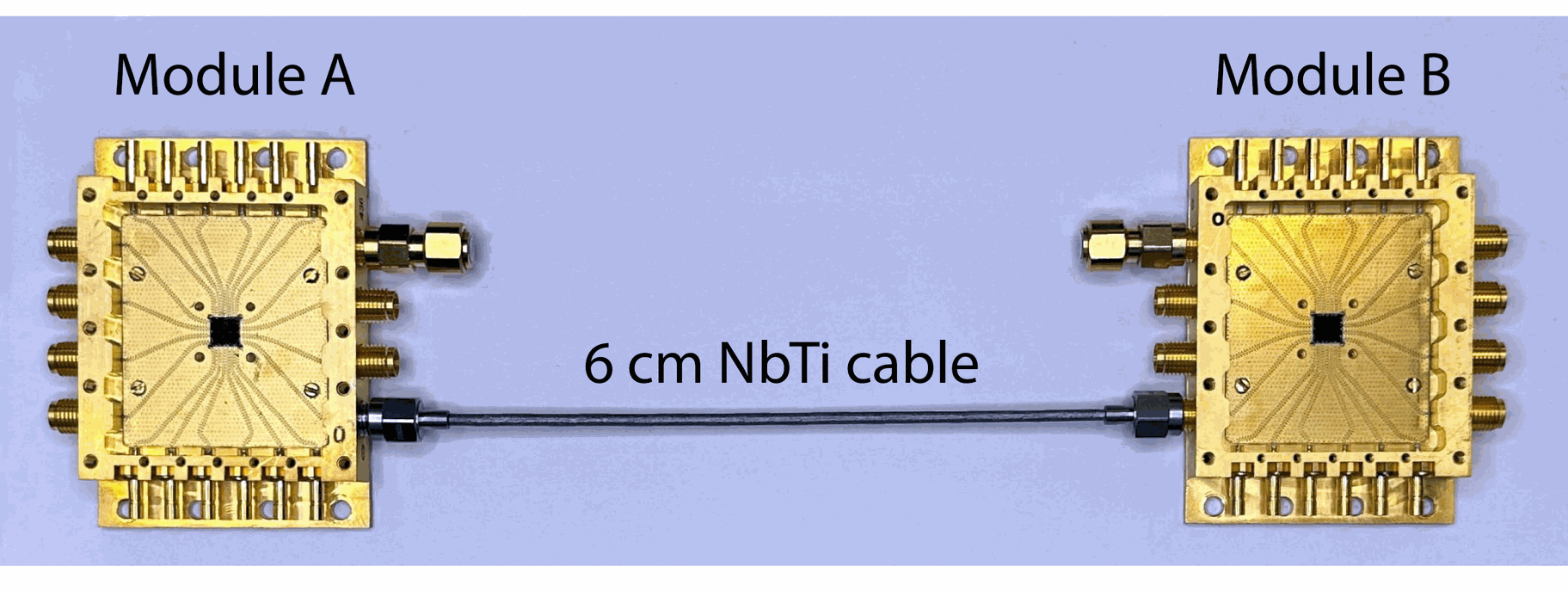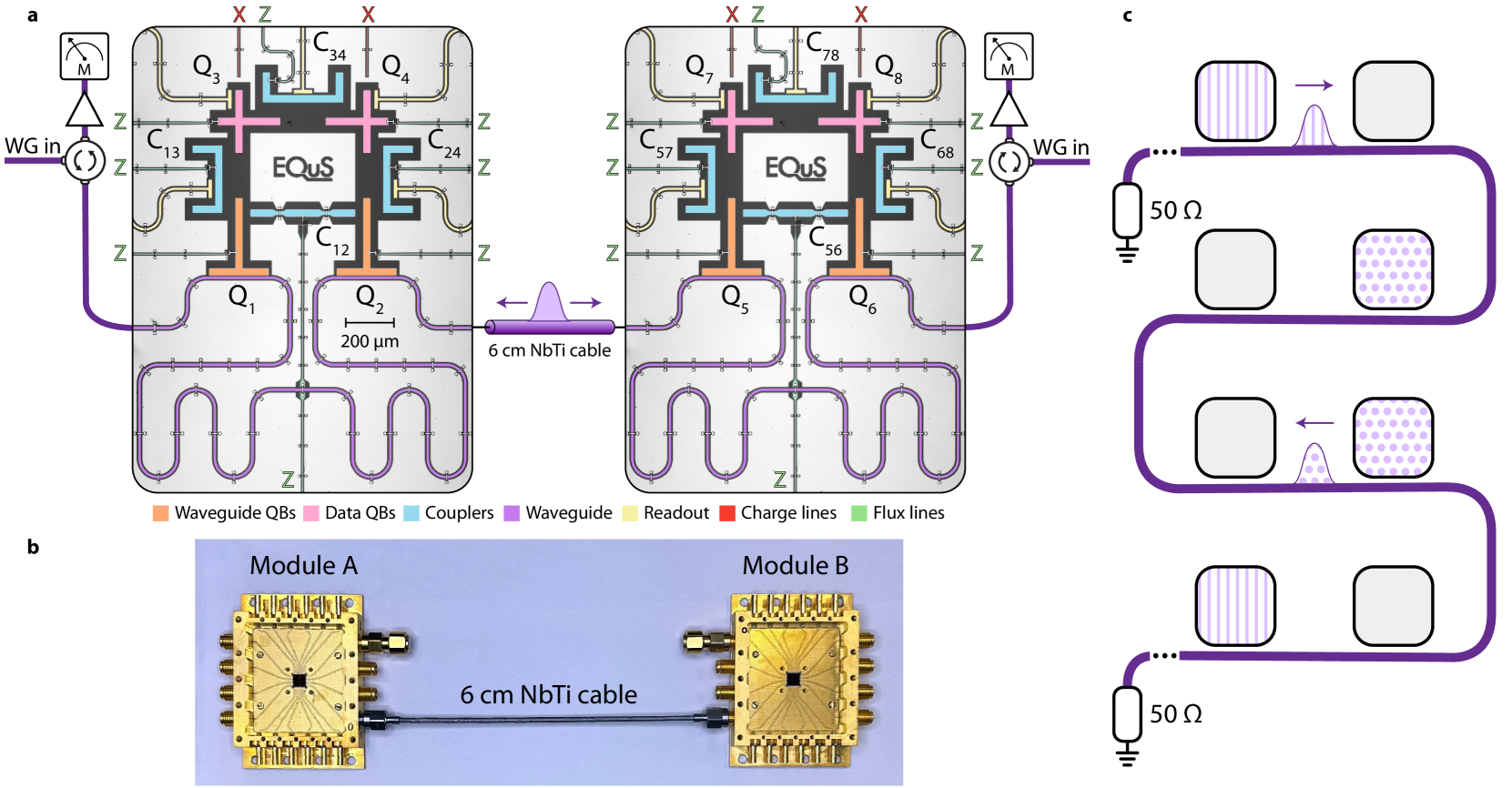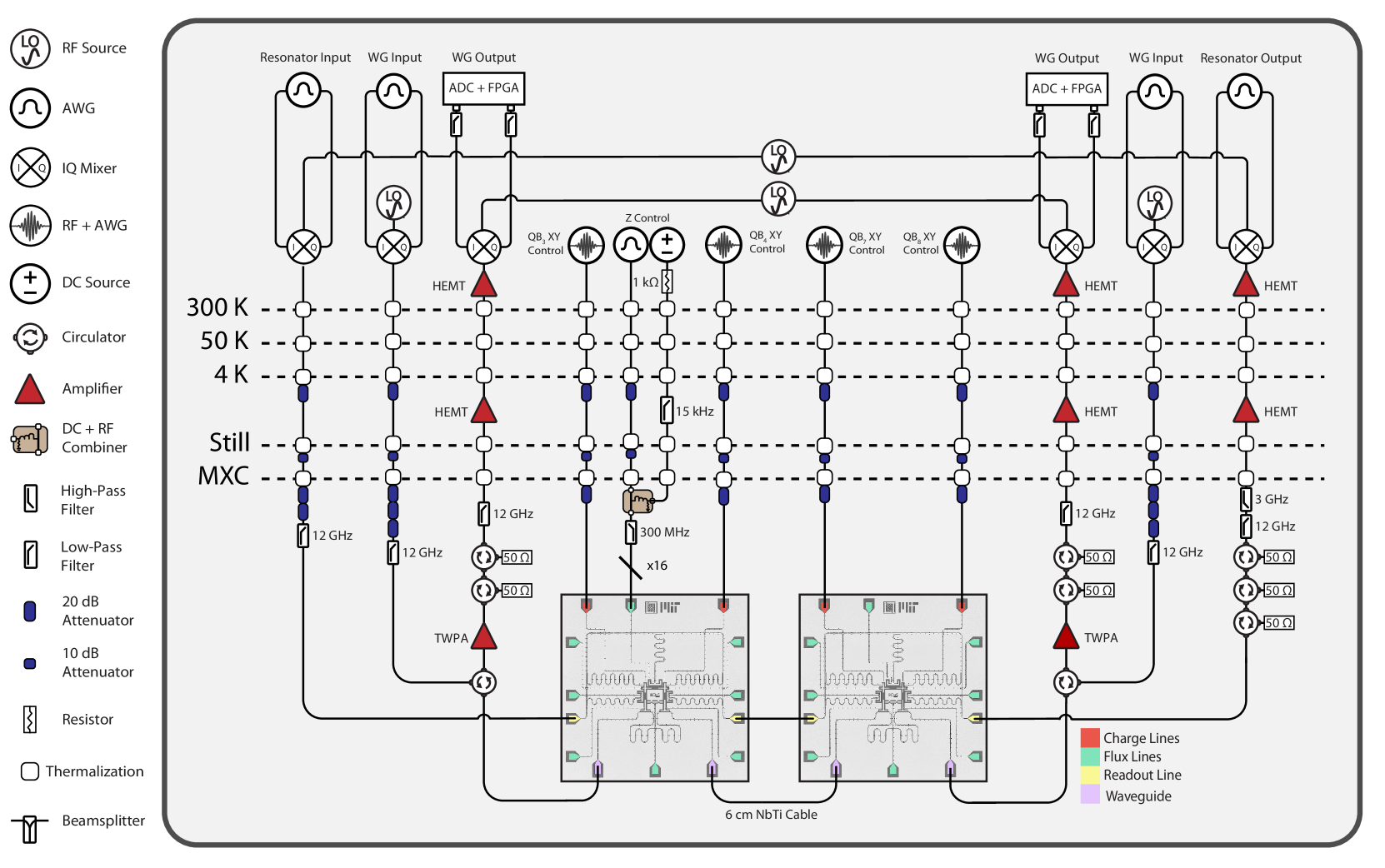MIT researchers have developed a photon-shuttling interconnect that enables direct communication between multiple superconducting quantum processors. This advancement could overcome scalability challenges in quantum computing by allowing efficient entanglement and information transfer between processors.
The scalable interconnect device enables direct communication among multiple quantum processors facilitating "all-to-all" communication, allowing quantum processors to send and receive quantum information on demand in a user-specified direction.
Representative photograph of experimental implementation of the interconnect. Each module is housed in a separate microwave package. The two packages are connected with a 6 cm NbTi superconducting cable through which directional photons propagate. This composite system is then operated at millikelvin temperatures in a dilution refrigerator utilizing standard techniques.
Key Takeaways
- The new device supports scalable, "all-to-all" communication among quantum processors.
- Demonstrates remote entanglement, a key step toward developing a powerful, distributed network of quantum processors.
- The interconnect can send photons at different frequencies, times, and in two propagation directions, enhancing network flexibility and throughput.
- Achieved over 60% photon absorption efficiency using a reinforcement learning algorithm.
- This technology could be expanded to other kinds of quantum computers and larger quantum internet systems, essential for scalable quantum networks
"Figure S1:Experimental setup. Wiring schematic of the device and all electronics used to perform the experiment. Note that only one flux line configuration is shown (green), but each qubit and coupler is coupled to a flux line with separate, but identical, control electronics."
Overview
Quantum computers have the potential to solve complex problems that are beyond the capabilities of classical supercomputers. Current methods ("point-to-point" ) involve complex intermediary circuits, which introduce noise and loss, reducing overall computational fidelity.
To overcome these challenges, MIT researchers have developed a new interconnect device that supports scalable, "all-to-all" communication. This allows all superconducting quantum processors in a network to communicate directly with each other.
The researchers created a network of two quantum processors and used their interconnect to send microwave photons back and forth on demand in a user-defined direction. Photons, which are particles of light, can carry quantum information.
The device includes a superconducting wire, or waveguide, that shuttles photons between processors and can be routed as far as needed. The researchers claim they can couple any number of modules to it, efficiently transmitting information between a scalable network of processors.
This interconnect was used to demonstrate remote entanglement, a type of correlation between quantum processors that are not physically connected. In quantum mechanics, entanglement is a phenomenon where two or more particles become linked in such a way that they share the same fate, regardless of the distance separating them.
If you measure the state of one entangled particle, you instantly know the state of the other, even if they are far apart. Remote entanglement is a crucial step toward developing a powerful, distributed network of many quantum processors.
The researchers used a reinforcement learning algorithm to "predistort" the photon, optimizing the protocol pulses to shape the photon for maximal absorption efficiency. They achieved a photon absorption efficiency greater than 60 percent, which is high enough to prove that the resulting state at the end of the protocol is entangled.
Why It's Important
This research addresses a critical challenge in quantum computing: the need for efficient and scalable communication between quantum processors. By enabling direct communication among multiple quantum processors, the technology paves the way for more powerful and distributed quantum networks.
The ability to achieve remote entanglement with high fidelity is a significant milestone in quantum computing, as it allows for parallel operations between distant qubits.
The potential implications of this research extend beyond quantum computing to other domains such as quantum internet systems. This could lead to more powerful and scalable quantum computers, with applications in cryptography, materials science, and complex optimization solutions.

"Figure 1: Chiral quantum interconnect experimental set-up. a) False-colored optical micrographs of the devices and experimental schematic. Each module is capable of directional photon emission and absorption. The tunable couplers (blue) mediate interactions between pairs of data qubits (pink) and waveguide qubits (orange), which serve to emit and absorb directional photons to and from the waveguide. The photons propagate through a waveguide (purple) terminating in a measurement chain at both ends. Waveguide in (WG in) denotes microwave ports that enable an independent assessment of losses due to wirebonds, connectors, and normal-metal traces (see Supplementary Information). X and Z correspond respectively to qubit transverse and longitudinal drives. b) Representative photograph of experimental implementation of the interconnect. Each module is housed in a separate microwave package. The two packages are connected with a 6 cm NbTi superconducting cable through which directional photons propagate. This composite system is then operated at millikelvin temperatures in a dilution refrigerator utilizing standard techniques. c) Conceptual diagram of an all-to-all quantum network using chiral wQED. Modules are tiled along an arbitrarily long, one-dimensional waveguide and in principle serve as interfaces to individual quantum processing nodes. Directional photons mediate communication between modules, which function in three modes: emission, absorption, and transparency by adjusting the frequencies of the waveguide qubits (on-resonance with the emitted photon for absorption, and off-resonance for transparency). We show an example of two communication protocols, where the dotted and striped pairs of modules each communicate via microwave photons propagating in opposite directions, bypassing transparent (gray) modules in between. With this scheme, we can distribute entanglement between modules on the waveguide."
Summary of Results
The researchers developed a scalable interconnect device that enables "all-to-all" communication among quantum processors. This demonstrated that by creating a network of two quantum processors and using the interconnect to send microwave photons back and forth on demand. The device includes a superconducting wire that shuttles photons between processors, allowing for efficient information transmission.
The interconnect was used to achieve remote entanglement, a key step toward building a large-scale quantum processor from smaller-scale modules. The researchers used a reinforcement learning algorithm to optimize the absorption efficiency of the photons, achieving an efficiency greater than 60 percent. This high absorption efficiency proves that the resulting state is entangled, a major milestone in quantum computing.
Conclusion
The research is a significant advancement in quantum computing. The development of a scalable interconnect device that enables direct communication among multiple quantum processors addresses a critical challenge in the field for powerful distributed quantum computing.
The achievement of remote entanglement with high fidelity paves the way for more powerful and distributed quantum networks, with potential applications in quantum internet systems and other domains.


Quantum Processors Can Now Communicate Paving the Way for Distributed Quantum Networks
Deterministic remote entanglement using a chiral quantum interconnect